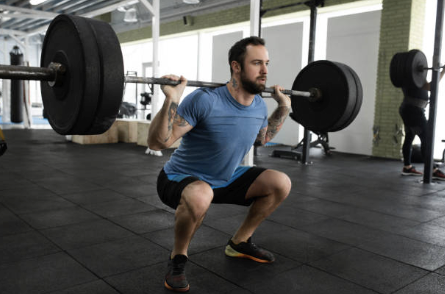As a physiotherapist, I have the privilege to work with different sporting population, from weekend warriors to professional athletes. In all these population, one thing is common is that they want to recover, prevent injuries and stay active. For this reason, strength and condition plays an important role for them to continue to enjoy their sports and participate at the peak performance. Whether you’re into football, basketball, soccer, swimming, or any other sport, improving strength involves focusing on a balanced training routine that addresses your specific needs for that particular sport. Here’s a step-by-step guide to help you get stronger for your sport.
1. Understand Your Sport’s Strength Requirements
Each sport has its own unique demands. Sports like football and rugby require raw power, while basketball or tennis demand explosive strength and endurance. Understanding which muscles and movements are most crucial for your sport is key to building an effective plan.
- Power and contact sports (like rugby, football): Focus on overall body strength and explosive power.
- Endurance sports (like soccer, swimming): Combine strength training with endurance exercises.
- Agility-based sports (like tennis, basketball): Focus on explosive movements, core stability, and coordination.
2. Strength Training Basics
To get stronger, focus on three key areas: compound lifts, progressive overload, and proper recovery.
Compound Lifts
Compound exercises work multiple muscle groups at once, which builds overall strength and stability. These exercises are a foundation for any sport-specific program. Key compound lifts include:
- Squats: Build leg and core strength, which is essential for sprinting, jumping, and stability.
- Deadlifts: Improve your entire posterior chain (back, glutes, hamstrings) for running, tackling, and balance.
- Bench Press: Helps with upper body strength, important in contact sports and for pushing movements.
- Pull-Ups/Rows: Build pulling strength and back muscles, useful for grappling sports and overall upper body balance.
Progressive Overload
Progressive overload means gradually increasing the weight or intensity of your exercises to continue challenging your muscles. Without increasing the demand on your muscles, they won’t adapt and grow. Track your lifts, aim to increase weights, and vary the reps over time. It is also important to work both on power. The term power refers to explosive strength, it is the ability to use strength at speed. For example, 3-4 sets of 3-5 reps with long rest periods of 3min+ between sets is ideal for power development.
Proper Form and Technique
Lifting heavy is essential, but never at the cost of form. Improper technique can lead to injury, negating any progress. Focus on perfecting form first, especially with heavier lifts, and consider working with a coach to ensure you’re performing exercises correctly.
3. Sport-Specific Exercises
Once you’ve established a foundation of strength, start adding sport-specific exercises. Tailor your training to focus on movements and strength areas relevant to your performance.
- Plyometrics: Explosive exercises like box jumps, sprints, or clap push-ups help translate strength into power, vital for sports requiring short bursts of speed or power.
- Agility and Reaction Training: Incorporate ladder drills, cone drills, and quick-directional changes to improve coordination and agility. These exercises are crucial in sports like basketball, soccer, and tennis.
- Core Training: A strong core stabilizes your body during most athletic movements. Exercises like planks and medicine ball throws strengthen your core and translate to better balance and control during competition.
4. Nutrition for Strength Gains
To build strength, you need to fuel your body with the right nutrients. Adequate protein intake is critical for muscle repair and growth. Don’t neglect carbohydrates, which provide energy for intense training sessions, and healthy fats, which aid recovery and hormone production.
- Pre-workout: Fuel up with complex carbohydrates and some protein to give your muscles the energy they need.
- Post-workout: Focus on protein to repair muscle and replenish glycogen stores with some carbs.
5. Recovery and Rest
Recovery is just as important as the workout itself. Your muscles need time to repair and grow after heavy lifting sessions. Ensure you’re getting adequate rest between training sessions and sleeping enough (7-9 hours per night). Active recovery, such as stretching, foam rolling, or light swimming, can help reduce soreness and improve flexibility.
6. Injury Prevention
Strength training not only boosts performance but also helps prevent injuries by fortifying muscles, ligaments, and joints. Don’t forget to include mobility work, proprioception exercises, dynamic warm-ups, and cooldowns in your routine to maintain flexibility and prevent strains or pulls.
7. Periodization and Planning
Periodization involves cycling your training to prevent burnout and maximize gains. Consider splitting your year into blocks:
- Off-season: Focus on building raw strength and muscle mass.
- Pre-season: Shift towards sport-specific training with more explosive and endurance-based exercises.
- In-season: Maintain your strength gains with lower volume and intensity, focusing more on skill and tactical training.
Conclusion
Physiotherapist are allied health professionals who focuses on the assessment, treatment and prevention of movement injuries. Myphysio physiotherapists can provide you with a tailored treatment program. Our experienced physiotherapist will be able to provide you with a custom-made exercise program to keep your muscles and joints in optimal condition. Book an appointment today to get your health journey started with our friendly team. You can also follow us on Facebook or Instagram for tips on managing your injury.
This information is for educational purposes only and is not intended to replace the advice of your doctor or health care professional. We encourage you to discuss any questions or concerns you may have with your health care provider.

